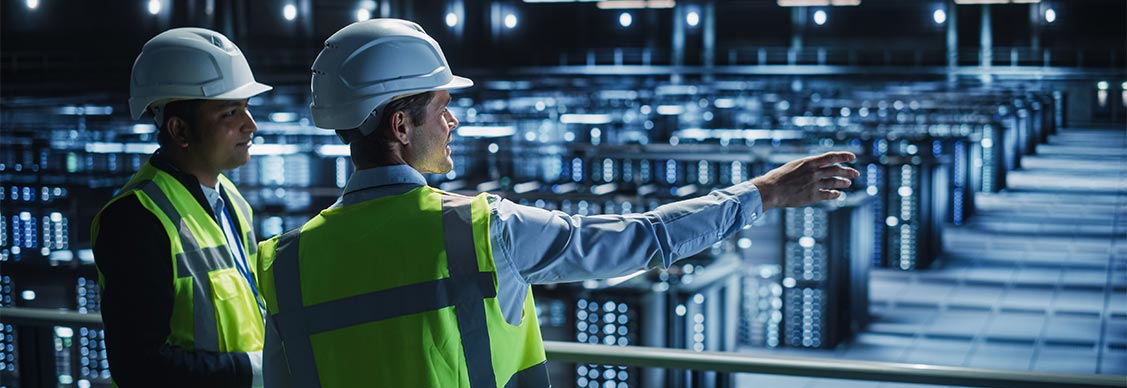Why data centers could hit obsolescence sooner than you think
AI and emerging technologies risk leaving current projects short of power
In a world increasingly fuelled by the internet, data, and artificial intelligence, demand is rising for the real estate that makes it all happen.
Companies on the hunt for more space pushed take-up for data centers to a record 352MW in Europe last year, while primary markets in North America jumped from 1.74GW to 3.45GW of net absorption, according to JLL analysts.
In response, construction is ramping up. The number of data centers in Ireland – which thanks to its proximity to Europe and cooler climate has become a digital gateway hub – is expected to grow 65% in coming years with 14 under construction, and another 40 already approved, according to the International Energy Agency. Leading data center construction firm Winthrop Technologies has projects in seven different European countries, while Blackstone and Digital Realty are partnering in a $7 billion joint venture to construct ten data centres in Frankfurt, Paris and northern Virginia.
The problem: new data centers risk becoming obsolete. This is largely driven by the ever-increasing power needed to deal with expanding amounts of data, which is projected to double in the next five years, when compared to the past decade, according to business intelligence firm Statista.
“Technology is evolving fast, which means data center design and operations must adapt, too,” says Hanayyah Sutton Head of Data Center Projects and Development Services for EMEA. “Given projects can take two to three years to come online, a clear understanding of future demand type and target customer is key to delivering fit-for-purpose facilities.”
Looking for more insights? Never miss an update.
The latest news, insights and opportunities from global commercial real estate markets straight to your inbox.
Power struggles
Power densities are rapidly increasing to support advanced IT loads. Data center rack density will grow from 36kW to 50kW per rack by 2027. Centers dedicated to AI training could hit as much as 80-100kW per rack, meaning changes to the way equipment is cooled.
“Higher density implies heavier racks, which effects floorplate loads and footprint, while increased heat generation is resulting in a shift away from traditional air cooling towards various types of liquid cooling,” says Jordi Sinfreu, Head of Data Centers for Southern Europe. “Plus hyperscale, edge and AI all require different mechanical, electrical and design considerations.”
Meanwhile, increasingly tough sustainability performance regulations and reporting requirements are making water and power efficiency paramount. And with the average commercial data center reportedly costing between $10 million and $12 million per megawatt to construct, the stakes couldn’t be higher when it comes to future-proofing data center design, says Sinfreu.
Project planning to avoid obsolescence
With more and larger data center construction requirements emerging, it’s a fine balance between the need for speed to market and the complexities that come with critical infrastructure projects.
Sinfreu says that staggering investment and taking a phased approach to development is one way to remain agile and avoid obsolescence. “It allows for greater flexibility as market conditions may change over the duration of the project,” he says.
This could mean adapting the design and layout of floors or halls or tapping into new sources of renewable energy as they become available.
And while retrofitting existing data centers to extend their life span is far from easy (Sinfreu likens it to carrying out delicate keyhole surgery), with careful planning, it’s not entirely impossible.
“Detailed CAPEX and asset lifecycle planning can help manage judicious use of budget for upgrades or allow for replacement of older equipment,” says Sutton. “This can allow operators to take advantage of newer, more efficient technologies, reducing total cost of ownership, rather than wasting money on maintaining and repairing old kit.”
Microsoft aims to run water-positive, zero-waste data centers by 2030, while Amazon Web Services are the world’s largest renewable energy buyer thanks to their data center power-transition strategy.
Finding the right partner
Choosing the right project partner is vital to reducing the risk of baked in obsolescence. But thanks to a lack of skilled talent, finding the right capability is not always straightforward.
Sutton suggests that where possible, global big picture experience, combined with insights from local boots on the ground is the way forward. This ensures the breadth of relevant expertise required in everything from financing and sustainability to acquiring local permits.
“It’s important to think about the complete end-to-end process and the knock-on effects of any design changes” she says. “Success comes from having clarity, not just in strategic planning, procurement, project management and delivery, but also in post-commissioning operation and maintenance.”
Contact Hanayyah Sutton
Head of Data Center Projects and Development Services for EMEAWhat’s your investment ambition?
Uncover opportunities and capital sources all over the world and discover how we can help you achieve your investment goals.
